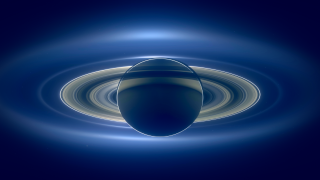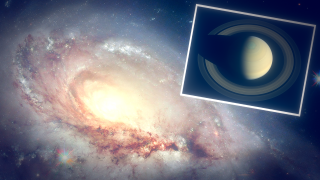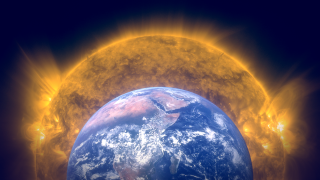The MOST AMAZING Media From SPACE
Published: August 16, 2025 at 10:42 PM (PT)
7:40
(13814 frames/30fps) Resolution:3840x2160
(4K/UHD) Most Rewatched:5:21 to 5:58 Realtime Statistics...
30 Minutes...
Hour...
24 Hours...
Information Sources
https://svs.gsfc.nasa.gov/30520/
Earth Waves at Saturn in Colossal NASA Collage (Photo)https://www.space.com/22462-wave-at-saturn-earth-photo-collage.html
Saturn's Hexagonhttps://en.wikipedia.org/wiki/Saturn%27s_hexagon
Saturn's Hexagon Recreated in a Labhttps://people.seas.harvard.edu/~rwordsworth/papers/barbosa2010laboratory.pdf
Comet Shoemaker-Levy 9https://en.wikipedia.org/wiki/Comet_Shoemaker%E2%80%93Levy_9
Energy of Little Boyhttps://en.wikipedia.org/wiki/Little_Boy
Earthrisehttps://en.wikipedia.org/wiki/Earthrise
First Flight of Ingenuityhttps://www.youtube.com/watch?v=wMnOo2zcjXA
Venera 14https://en.wikipedia.org/wiki/Venera_14
Missions to Venushttps://en.wikipedia.org/wiki/List_of_missions_to_Venus
Whistler-mode Waveshttps://www.nasa.gov/missions/mms/nasa-listens-in-as-electrons-whistle-while-they-work/
Saturn's Radio Emissionshttps://www.youtube.com/watch?v=hWHLCHv4PiI
A Decade of Sun-SDOhttps://www.youtube.com/watch?v=l3QQQu7QLoM
NASA Releases the First Webb Photoshttps://webbtelescope.org/contents/news-releases/2022/news-2022-028
Hubble by the Numbershttps://science.nasa.gov/mission/hubble/overview/hubble-by-the-numbers
Hubble Launch Datehttps://science.nasa.gov/mission/hubble/science/universe-uncovered/hubble-deep-fields/
Graphic Sources
https://webbtelescope.org/contents/media/images/2022/057/01GKMKC1AF19PVC0X5JF6BH5X0
Camera Icon (Daniel Roberts)N/A
Video Camera Icon (Daniel Roberts)N/A
Audio Icon (Daniel Roberts)N/A
The Day The Earth Smiled (NASA)https://images.nasa.gov/details/PIA17172
Saturn's Hexagon Storm (NASA)https://photojournal.jpl.nasa.gov/catalog/PIA21611
Jewel of the Solar System (NASA)https://photojournal.jpl.nasa.gov/catalog/PIA17474
Comet Shoemaker-Levy 9 Fragment W Impact Photos (NASA)https://science.nasa.gov/resource/comet-shoemaker-levy-9-fragment-w-impact-with-jupiter
Comet Shoemaker-Levy 9 Impact Video (individual frames) (NASA (SAAO/Dr. K. Sekiguchi))https://images.nasa.gov/details/299_ImpactsOfSL9
Little Boy (Daniel Roberts)https://pixabay.com/vectors/bomb-little-boy-atomic-nuclear-9082605
Earthrise (NASA)https://en.wikipedia.org/wiki/Earthrise#/media/File:AS08-14-2383.jpg
Video of the First Flight of Ingenuity (NASA)https://www.youtube.com/watch?v=wMnOo2zcjXA
Ingenuity Aerial Photo (PIA24593) (NASA)https://photojournal.jpl.nasa.gov/catalog/?IDNumber=PIA24593
Ingenuity Aerial Photo (PIA25884) (NASA)https://photojournal.jpl.nasa.gov/catalog/?IDNumber=PIA25884
Ingenuity Aerial Photo (PIA24600) (NASA)https://photojournal.jpl.nasa.gov/catalog/?IDNumber=PIA24600
Venus Surface Panorama from Venera 14 Front Camera (Russian Academy of Sciences/Ted Stryk)https://www.planetary.org/space-images/venus-surface-panorama-from-venera-14-camera-1
Venus Surface Panorama from Venera 14 Rear Camera (Russian Academy of Sciences/Ted Stryk)https://www.planetary.org/space-images/venus-surface-panorama-from-venera-14-camera-2
Venus Surface Panorama from Venera 9 (Russian Academy of Sciences/Ted Stryk)https://www.planetary.org/space-images/venus-surface-panorama-from-venera-9
Earth (Daniel Roberts)https://pixabay.com/vectors/earth-planet-space-terrestrial-8233221
Lightning (Daniel Roberts)N/A
Saturn (Daniel Roberts)https://pixabay.com/vectors/saturn-planet-space-terrestrial-8233220
The Sun (Daniel Roberts)https://pixabay.com/vectors/sun-star-space-solar-light-bright-8328084
The Sun Now (2025-07-30 20:57:22 UT) (NASA)https://sdo.gsfc.nasa.gov/data
Lunar Transit/Solar Eclipse from the SDO (NASA)https://sdo.gsfc.nasa.gov/gallery/main/item/953
Transit of Venus from the SDO (NASA)https://sdo.gsfc.nasa.gov/gallery/main/item/143
Transit of Mercury from the SDO (NASA)https://sdo.gsfc.nasa.gov/gallery/main/item/712
Comet Disintegrating from the SDO (NASA)https://sdo.gsfc.nasa.gov/gallery/potw/item/318
Jupiter, PJ24-22 (NASA)https://www.missionjuno.swri.edu/junocam/processing?id=7957
Jupiter's Great Red Spot (NASA)https://www.missionjuno.swri.edu/junocam/processing?id=7270
Jupiter (Polar Close Up) (NASA)https://www.missionjuno.swri.edu/junocam/processing?id=17704
Io and Jupiter (NASA)https://www.missionjuno.swri.edu/junocam/processing?id=16851
Jupiter and Shadow of Io (NASA)https://www.missionjuno.swri.edu/junocam/processing?id=7481
Juno's Final Approach to Jupiter (timelapse) (NASA)https://www.youtube.com/watch?v=wJiYoNN9lKk
Herbig-Haro 49/50 (NASA)https://webbtelescope.org/contents/media/images/2025/112/01JNGTQ49XY0NHG1Y31RAGYH1Y
Crab Nebula (NASA)https://webbtelescope.org/contents/media/images/2024/120/01J049D616EKYXVMNFKZZBWPCQ
Spiral Galaxy NGC 1566 (NASA)https://webbtelescope.org/contents/media/images/2024/105/01HM9ZFS5KC07R4TQWFQ0W9HMH
IC 348 (NASA)https://webbtelescope.org/contents/media/images/2023/151/01HFC82GPW3B8RPAJ3VWXJEAHZ
Lynds 483 (NASA)https://webbtelescope.org/contents/media/images/2025/111/01JM03BFKHQ4TXFENM7XQHY405
HH 211 (NASA)https://webbtelescope.org/contents/media/images/2023/141/01H9NWH9JEBFPKVD3M1RRTGGQJ
Uranus (Webb) (NASA)https://webbtelescope.org/contents/media/images/2023/150/01HHFNNWQTA69J6K680PVZN4A1
Neptune (Webb) (NASA)https://webbtelescope.org/contents/media/images/2022/046/01GCCV8F0SPYKD6Q7T513CTKGC
NGC 1961 (NASA)https://science.nasa.gov/missions/hubble/hubble-images-a-peculiar-spiral
Hubble Ultra Deep Field (NASA)https://en.wikipedia.org/wiki/Hubble_Ultra-Deep_Field#/media/File:Hubble_ultra_deep_field_high_rez_edit1.jpg
Orion Nebula (NASA)https://science.nasa.gov/asset/hubble/hubbles-sharpest-view-of-the-orion-nebula
Trifid Nebula and Lagoon Nebula (RubinObs/NOIRLab/SLAC/NSF/DOE/AURA)https://rubin.canto.com/v/RubinFirstLook/album/P2QMF?viewIndex=2&display=curatedView&column=image&id=n4kvj0cemd5pbdqgtjdgp2jg2t
Ring Nebula (NASA)https://webbtelescope.org/contents/media/images/01H82G0PP38P6PBXQ11BEVSMY0
L1527 and Protostar (NASA)https://webbtelescope.org/contents/media/images/2022/055/01GGWCXTEXGJ0C3FWSCB3SDBV5
Veil Nebula (NASA)https://science.nasa.gov/image-detail/veil-nebula
Pillars of Creation (NASA)https://webbtelescope.org/contents/media/images/2022/052/01GF423GBQSK6ANC89NTFJW8VM
Jupiter Cyclones (NASA)https://www.missionjuno.swri.edu/junocam/processing?id=13943
The Blue Marble (NASA)https://en.wikipedia.org/wiki/The_Blue_Marble#/media/File:The_Blue_Marble,_AS17-148-22727.jpg
Sombrero Galaxy (NASA)https://science.nasa.gov/asset/hubble/sombrero-galaxy-2
Question Mark Galaxy Cluster (NASA)https://science.nasa.gov/missions/webb/nasas-webb-reveals-distorted-galaxy-forming-cosmic-question-mark
The Day the Earth Smiled (Pale Blue Dot) (NASA)https://photojournal.jpl.nasa.gov/catalog/PIA17171
Audio Sources
N/A
Beyond the Abyss (Daniel Roberts)https://pixabay.com/music/ambient-beyond-the-abyss-2-58-336507
Venera 14 Venus Audio (Soviet Academy of Sciences)https://archive.org/details/venera-14-venus-recording
Thunder (Daniel Roberts)https://pixabay.com/sound-effects/thunder-245174
Whistler-mode Waves (NASA)https://www.nasa.gov/missions/mms/nasa-listens-in-as-electrons-whistle-while-they-work
Radio Emissions of Saturn and Enceladus (NASA)https://www.youtube.com/watch?v=hWHLCHv4PiI
Space is spectacular! But many
of us have no idea some of the
incredible photos, videos, and
sounds that have been captured
of space. So here is what I consider
to be the most amazing real media
of space.
On July 19, 2013, NASA's Cassini
spacecraft dipped into the shadow
of Saturn and captured one of
the most amazing photographs ever;
The Day The Earth Smiled. Since
the Sun is eclipsed, you can easily
see Saturn's rings, a few of its
moons, Mars, Venus, and Earth.
The image gets its name because
it was the first time that people
on Earth knew in advance that
they were going to be photographed
from interplanetary distances.
On this day, over 20,000 people
waved at Saturn from Earth.
Also related to Saturn is Saturn's
hexagon storm. Seeing such a symmetrical
storm in nature is fascinating!
We have actually been able to
recreate this effect in labs,
so it's no longer as mysterious
as it once was. But it's still
just as amazing!
Although poor quality, the photos
of the fragments of comet Shoemaker-Levy
9 colliding with Jupiter are spectacular.
Not only was this the first time
humans witnessed a collision between
two significant Solar System bodies,
but the result of the 21 collisions
left scars on the planet for months.
The most powerful of the 21 collisions
was from fragment G. The collision
released energy equivalent to
about 6 million megatons of TNT,
about the energy of 400 million
atomic bombs!
Perhaps one of the most iconic
and well known images in our list
is the famous Earthrise photo.
The photo was captured by Apollo
astronaut William Anders on December
24, 1968. He later stated, "We
set out to explore the moon and
instead discovered the Earth."
While not the best quality video
ever, the first flight of Ingenuity
certainly deserves a place in
this list! This was the first
powered flight on another planet.
Not only was this event amazing,
but so were the thousands of
aerial photos Ingenuity took of
the Martian surface during its
lifetime.
Another low resolution but amazing
thing from another planet is this
audio and these photos of the
surface of Venus. Captured during
the Russian Venera missions, this
audio is the real sound of Venus.
Real audio from a planet with
an atmosphere so extreme that
the lander was destroyed within
an hour.
This panorama from Venera 9
is composed of the first images
ever taken from the surface of
another planet.
To this day, the Russian Venera
and Vega landers are the only
landers to successfully land on
Venus, the last of them being
in 1984.
Earth also produces interesting
noises, although in this case
the "sound" is not vibrations
in the air but instead very low
frequency radio waves which have
been digitally converted to sound.
These are known as whistler-mode waves.
There are a few different types
of these. One of these is whistler
waves, which are caused by lightning
strikes on Earth. The lightning
creates a range of frequencies
and, since the higher frequencies
travel faster, the wave has a
falling pitch, giving them the
name whistler.
Then there is chorus.
And plasmaspheric hiss, which
is much less beautiful and honestly
a bit creepy.
Earth isn't the only planet
to have strange and eerie radio
emissions though. Saturn's plasma
waves sound very odd, although
in this case the audio is being
played back around 34 times faster
than real time.
Oh, I should specify that although
all this media is real, it is,
of course, enhanced and may be
be at different speeds than real
time or may be composited from
many different images.
Our Sun is beautiful, especially
the images captured by NASA's
Solar Dynamics Observatory while
orbiting Earth. The SDO has been
watching the Sun nearly non-stop
for 15 years! In that time it
has captured solar eclipses, the
transit of Venus, the transit
of Mercury, and just so much more.
Being able to observe the Sun
like this is amazing!
It even captured a comet disintegrating
as it grazed the Sun!
Anyway, as cool as that is,
this video is about more than
just the Sun.
The Juno mission has captured
some of the most amazing photos
of Jupiter! From the Great Red
Spot to the poles to moons to
moon shadows...Juno has really
captured Jupiter's design like
nothing else has! And even an
incredible time lapse of the Jovian
system as the spacecraft approached
the planet.
Since its launch in 2021, or
rather since its first images
in 2022, the James Webb Space
Telescope has not disappointed!
It is now responsible for capturing
some of the most breathtaking
photos of deep space objects.
And even some photos of objects
in our Solar System.
Of course, it's predecessor,
the Hubble Space Telescope, is
also responsible for some of the
most incredible photos of space!
It has captured over 1.6 million
images since 1990.
Even newer than the James Webb
Space Telescope is the Rubin Observatory
which has captured some absolutely
amazing and incredibly high-resolution
photos of space!
And in addition to all that
has already been shown, there
are thousands of other incredible
images from many different missions!
Oh and if you know of some amazing
media which wasn't included in
this list, I actually asked the
BlenderTimer community what space
themed media was their favorite.
So if you want to be part of the
next survey, consider joining
our community Discord server so
you can get notified whenever
there's a new community post!


 August 16, 2025
August 16, 2025 August 16, 2025
August 16, 2025